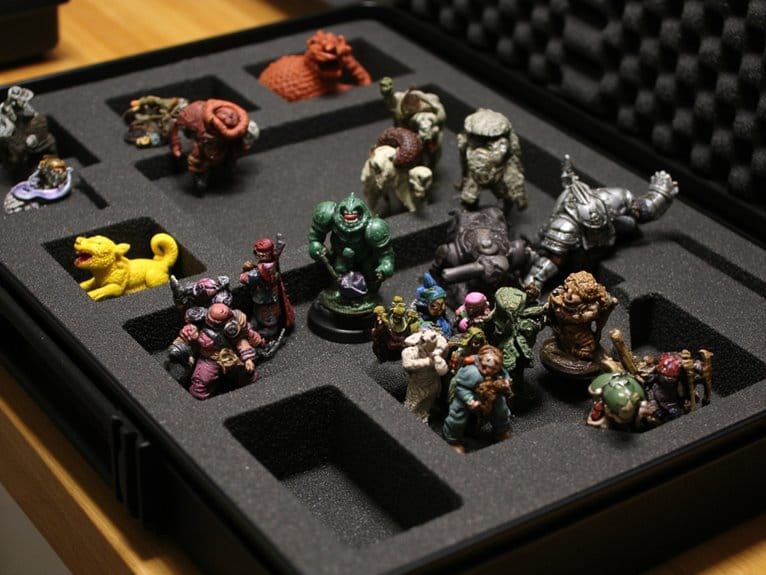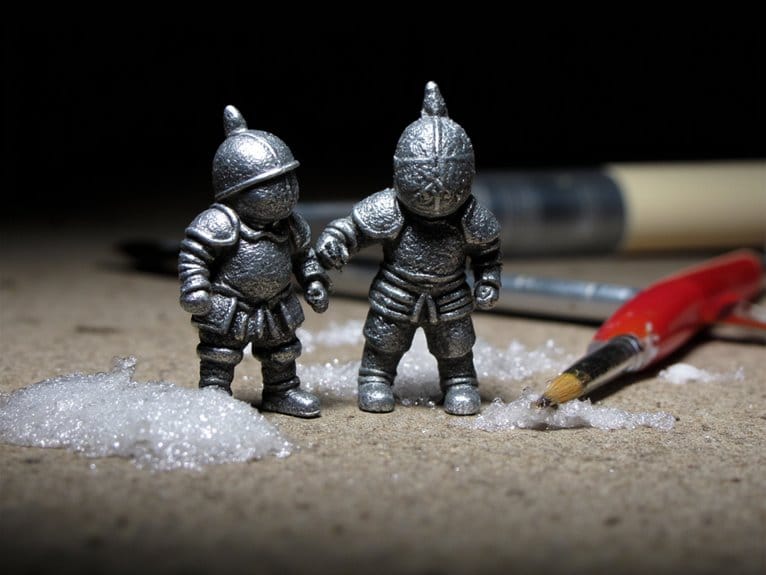We are supported by our audience. When you purchase through links on our site, we may earn an affiliate commission, at no extra cost for you. Learn more. Last update on 3rd July 2025 / Images from Amazon Product Advertising API.
Starting before painting is essential in achieving a cohesive and professional finish in miniature projects. It sets the foundation for the overall look, seamlessly integrating the model with its environment. Choosing the right base color scheme and theme influences the painting process, enhancing realism and attention to detail. By blending the base color onto the miniature’s feet and adding washes, a polished final appearance can be guaranteed. This step is vital for achieving a visually appealing result.
Importance of Proper Basing
When it comes to miniature painting, the significance of proper basing cannot be emphasized enough. One vital aspect of basing is painting the base. Before delving into intricate details on the miniature itself, the base sets the foundation for the overall look and feel of the model. By painting the base before working on the miniature, you guarantee a cohesive and harmonious end result.
Painting the base first allows for a seamless integration of the model with its environment. This approach enables you to map out the color scheme and theme of the base, which can influence your choices when painting the miniature itself. Whether you’re aiming for a gritty urban setting or a lush forest scene, the base provides the backdrop against which your miniature will shine.
Choosing the right colors and techniques to paint the base is imperative. It’s important to take into account factors like the setting of your miniature, the materials you’ll be using for basing, and the overall aesthetic you want to achieve. Well-executed basing not only enhances the realism of the miniature but also makes it stand out on the gaming table or display shelf. Proper basing can elevate the quality of your finished miniature and captivate viewers with its attention to detail.
Types of Primers for Basing
When it comes to primers for basing, choosing the appropriate type can have a major impact on the outcome of your miniature bases. Spray primers are excellent for covering large areas quickly and uniformly, while brush-on primers offer control for detailed applications. Understanding the characteristics of each primer type will help you achieve the desired results in your basing projects.
Spray Primers for Basing
Spray primers serve as an essential foundation for basing miniatures, offering a solid starting point for intricate painting details. When choosing a spray primer to base the mini, consider the desired effect on the final paint job. Black spray primers are excellent for creating shadows and depth, enhancing the overall realism of the miniature. On the other hand, white primers work well for brighter colors and highlights, giving a vibrant finish to the base. Grey spray primers provide a vital base that complements a wide range of paint colors, allowing for customization. Colored spray primers in tones like red, blue, or green offer unique effects and color variations, adding creativity to the painting process. Selecting the right spray primer is essential for achieving the desired outcome when painting the mini.
Brush-On Primers for Basing
Brush-on primers play an important role in preparing miniatures for painting by ensuring proper adhesion of paints and materials. When basing model trains, consider the following types of brush-on primers:
- Acrylic: Water-based, quick-drying, and easy to clean up, making them a popular choice among miniature painters.
- Polyurethane: Provides a tough, protective coat that is resistant to scratches and impacts, ideal for tabletop gaming miniatures.
- Enamel: Offers a glossy, smooth finish but requires longer drying times and proper ventilation due to its solvent-based nature.
Each type has its unique advantages, so choose the one that best suits your model train basing needs.
Steps for Priming Miniatures
Before embarking on painting your miniatures, it is important to grasp the essential steps for priming them effectively. Priming miniatures provides a base coat for the paint to adhere to, ensuring a smooth and lasting finish. To begin, make sure the miniature is clean and dry. This step is vital as any debris or moisture can cause issues with paint adherence. Using a spray primer is recommended for even coverage and to avoid visible brush strokes on the miniature. When choosing a primer color, consider that black, white, or gray primers can influence the final appearance of the paint job. Allow the primer to fully dry before proceeding to paint to prevent smudging or bubbling that could ruin the finish. Once the miniatures are primed, they are ready for the next step in the painting process. Remember, a well-primed miniature can make a significant difference in the final look of your painted models, so take the time to prime them correctly to keep your paint job looking its best.
Choosing Base Coat Colors
When selecting base coat colors for miniatures, it’s important to contemplate how they harmonize with the overall color scheme. Neutral or contrasting hues can elevate the miniatures’ visual impact. Matching the base coat to the theme or setting guarantees a unified and polished final look.
Color Selection Tips
Considering the color wheel when choosing base coat colors for miniatures is essential for achieving a visually appealing and cohesive overall look. When deciding on base coat colors, I recommend the following:
- Complementary or Contrasting Colors: Choose colors that either complement or contrast with the miniature’s primary colors to create interest and harmony.
- Neutral Tones for Versatility: Opt for neutral tones like gray or brown as base coats to provide a versatile backdrop for various miniature themes.
- Vibrant Colors for Impact: Introduce bright colors like red or blue to the base coat for a pop of vibrancy that enhances the overall appeal of the painted model.
Base Coat Importance
Selecting the appropriate base coat color is a fundamental step in establishing the visual foundation and thematic direction for miniature painting. The base coat sets the stage for the entire painting process, influencing how the subsequent layers of paint will appear. When choosing a base coat color, consider the mood and atmosphere you want to convey. For example, a dark base coat can create a more ominous or dramatic feel, while a lighter base coat may give a brighter and more cheerful vibe. Additionally, the base coat color should harmonize with the overall color scheme of the miniature. Experimenting with different base coat colors can lead to exciting and distinctive results, enhancing the overall appeal of your miniature painting.
Techniques for Base Coating
To achieve a smooth and consistent base coat, it is essential to control the application of paint with a steady hand and a consistent pressure. When base coating a miniature, here are three key techniques to keep in mind:
- Thin Layers: Applying thin layers of paint allows for better control and helps prevent obscuring fine details on the miniature. It is advisable to start with a thinned-down paint mixture to achieve a smooth and even base coat.
- Multiple Passes: Instead of trying to cover the entire base in one go, making multiple passes with the brush or airbrush can help build up the color gradually. This technique ensures a more even coverage and avoids pooling of paint in recessed areas.
- Even Coverage: Ensuring consistent coverage across the entire base is vital for a professional finish. Pay attention to areas that are easily overlooked, such as edges and corners, to maintain consistency throughout the base coating process.
Troubleshooting Basing Issues
When encountering issues with basing, addressing the consistency of the texture and color application is crucial to troubleshooting effectively. One common problem is an uneven base texture, which can be caused by applying the basing material too thickly or thinly. To rectify this, carefully remove excess material with a tool like a sculpting tool or a toothpick to achieve a smoother surface. Additionally, make sure that the base color is applied evenly to avoid patchiness. If the base color appears streaky or blotchy, consider applying thin layers and allowing each layer to dry before adding more paint.
Another issue that may arise is mismatched colors between the miniature and the base. To resolve this problem, blend the base color with the miniature’s feet by dry brushing a bit of the base color onto the feet or adding washes to tie the colors together seamlessly. It’s important to rectify any basing issues before proceeding with further painting to ensure a cohesive and polished final look.
Tips for Long-lasting Basing
For enhanced durability and visual appeal, start by applying a layer of white glue to the base using an old brush to establish a secure bond. When aiming for long-lasting basing effects, consider the following tips:
- Natural Textures: Utilize sand or crushed coral to create a realistic and organic appearance. These textures provide a solid foundation before adding rocks or other elements to your base.
- Detailed Painting: Begin by painting the base with a dark green shade, then carefully highlight with a lighter green to achieve a lifelike rock effect. This step enhances the overall look of your model first.
- Protective Sealing: To guarantee the longevity of your painted bases, apply a light coat of sealer. This protective layer helps safeguard the colors and textures from wear and tear over time.


